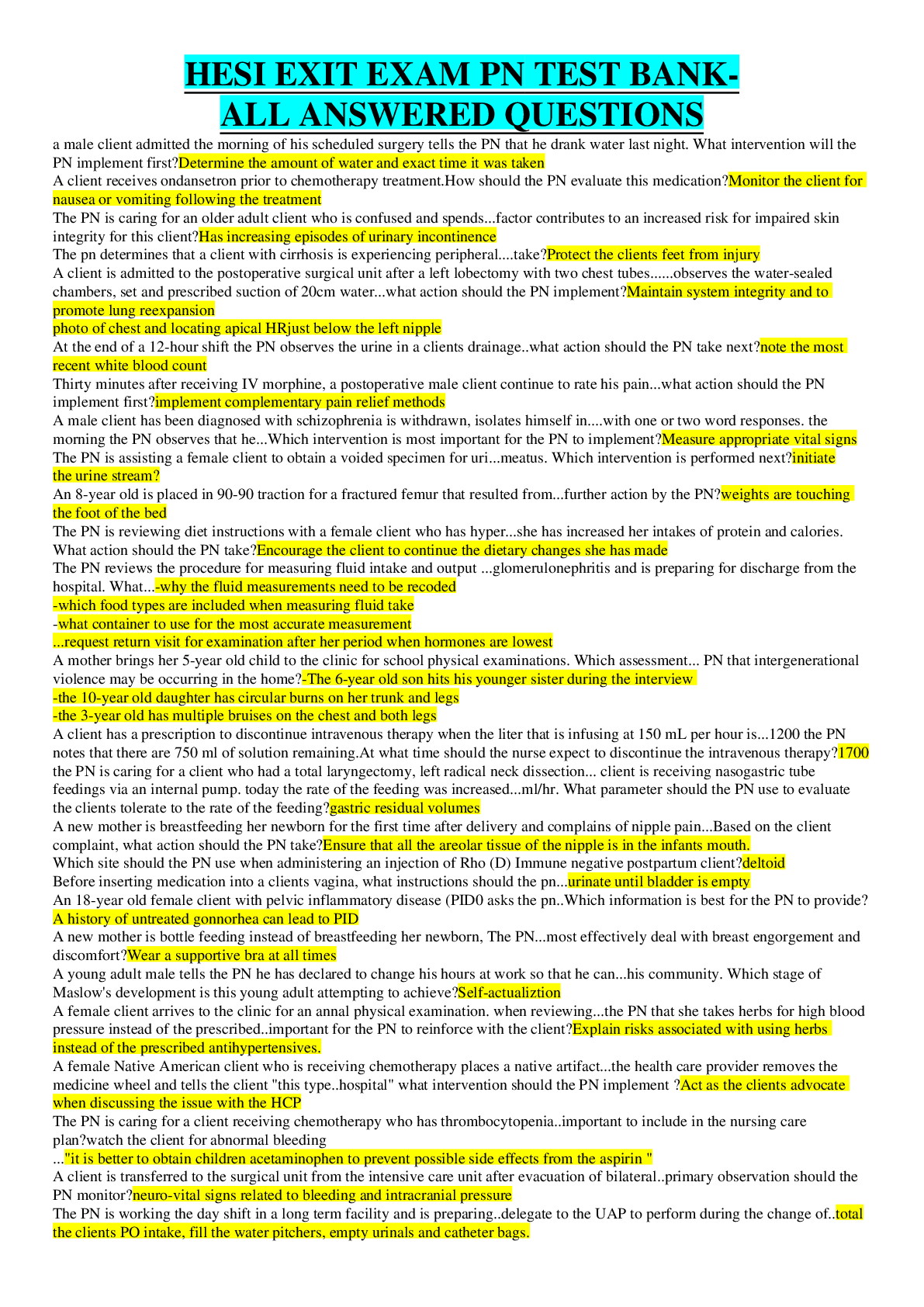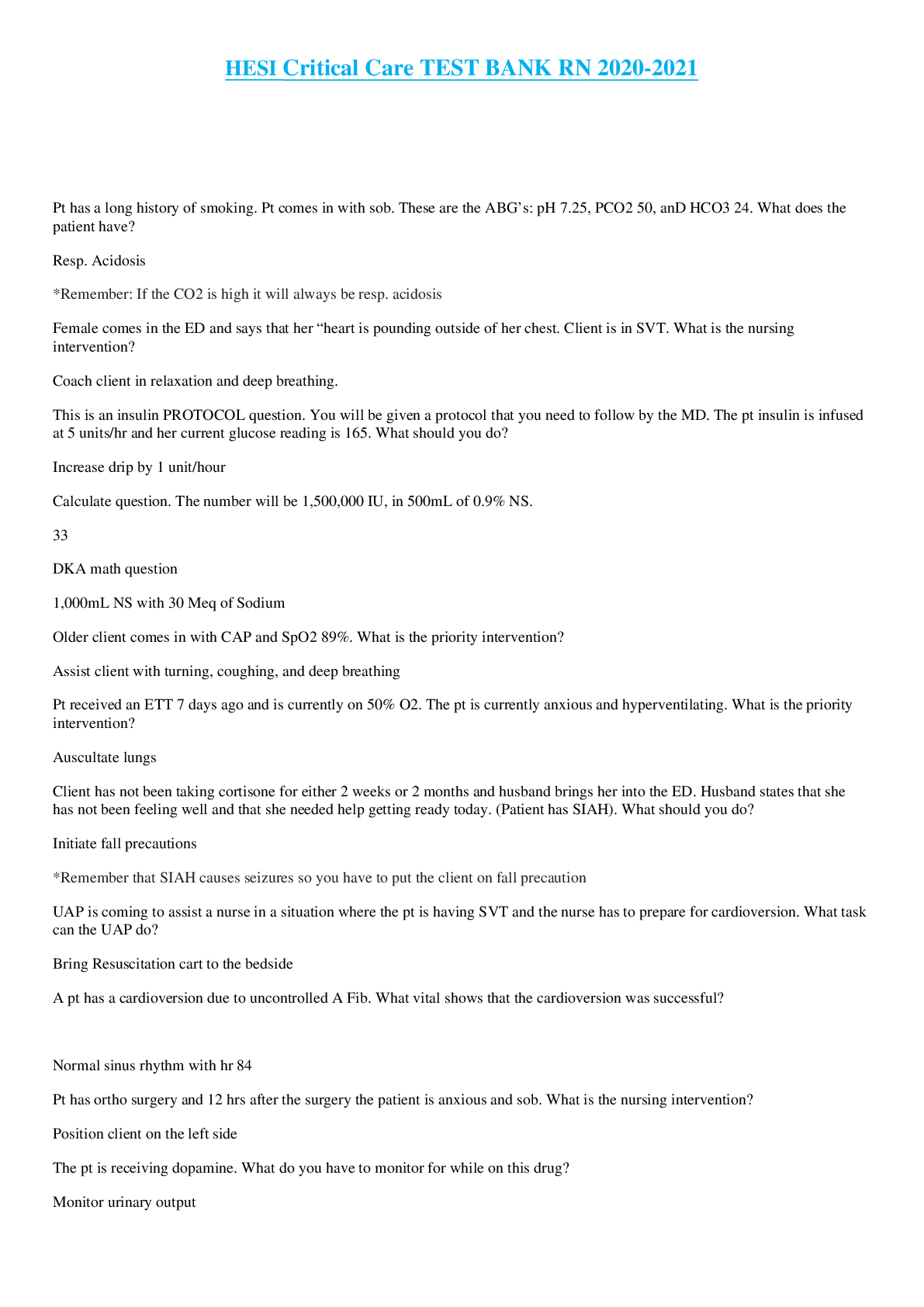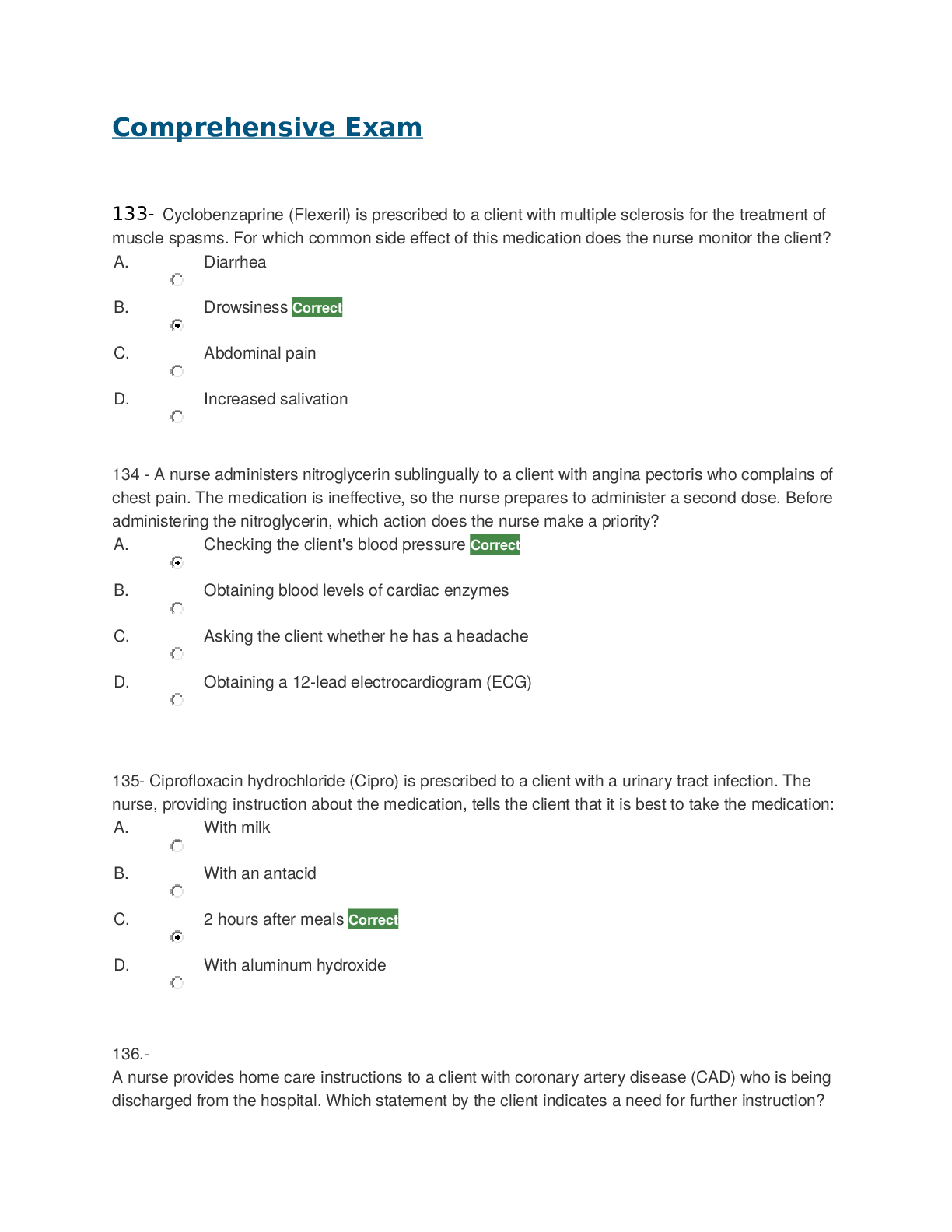CRITICAL_CARE_FINAL_TEST BANK - 100% CORRECT ANSWERS | CRITICAL_CARE_FINAL
Document Content and Description Below
Chapter 14 1. The nurse admits a patient to the critical care unit following a motorcycle crash. Assessment findings by the nurse include blood pressure 100/50 mm Hg, heart rate 58 beats/min, respira... tory rate 30 breaths/min, and temperature of 100.5°F. The patient is lethargic, responds to voice but falls asleep readily when not stimulated. Which nursing action is most important to include in this patient’s plan of care? a. Frequent neurological assessments b. Side to side position changes c. Range-of-motion to extremities d. Frequent oropharyngeal suctioning Nurses complete neurological assessments based on prescribed frequency and the severity of the patient’s condition. The newly admitted patient has an altered neurological status, so frequent neurological assessments are most important to include in the patient’s plan of care. Side to side position changes, range-of-motion exercises, and frequent oral suctioning are nursing actions that may need to be a part of the patient’s plan of care, but in the setting of increased intracranial pressure they should not be regularly performed unless indicated. 2. A patient with a head injury has an intracranial pressure (ICP) of 18 mm Hg. The blood pressure is 144/90 mm Hg, and mean arterial pressure (MAP) is 108 mm Hg. What is the cerebral perfusion pressure (CPP)? a. 54 mm Hg b. 72 mm Hg c. 90 mm Hg d. 126 mm Hg CPP = MAP – ICP. In this case, CPP = 108 mm Hg – 18 mm Hg = 90 mm Hg. All other calculated responses are incorrect. 3. While caring for a patient with a traumatic brain injury, the nurse assesses an ICP of 20 mm Hg and a CPP of 85 mm Hg. What is the best interpretation by the nurse? a. Both pressures are high. b. Both pressures are low. c. ICP is high; CPP is normal. d. ICP is high; CPP is low. The ICP is above the normal level of 0 to 15 mm Hg. The CPP is within the normal range. All other listed responses are incorrect. 4. The nurse is caring for a mechanically ventilated patient with a sustained ICP of 18 mm Hg. The nurse needs to perform an hourly neurological assessment, suction the endotracheal tube, perform oral hygiene care, and reposition the patient to the left side. What is the best action by the nurse? a. Hyperoxygenate during endotracheal suctioning. b. Elevate the patient’s head of the bed 30 degrees. c. Apply bilateral heel protectors after repositioning. d. Provide rest periods between nursing interventions. Sustained increases in ICP lasting longer than 5 minutes should be avoided. This is accomplished by spacing nursing care activities to allow for rest between activities. All other nursing actions are a part of the patient’s plan of care; however, spacing out interventions is the priority. 5. While caring for a patient with a basilar skull fracture, the nurse assesses clear drainage from the patient’s left naris. What is the best nursing action? a. Have the patient blow the nose until clear. b. Insert bilateral cotton nasal packing. c. Place a nasal drip pad under the nose. d. Suction the left nares until the drainage clears. In the presence of suspected cerebrospinal fluid leak, drainage should be unobstructed and free flowing. Small bandages may be applied to allow for fluid collection and assessment. Patients should be instructed not to blow their nose because that action may further aggravate the dural tear. Suction catheters should be inserted through the mouth rather than the nose to avoid penetrating the brain due to the dural tear. 6. The nurse is caring for a patient who was hit on the head with a hammer. The patient was unconscious at the scene briefly but is now conscious upon arrival at the emergency department with a GCS score of 15. One hour later, the nurse assesses a GCS score of 3. What is the priority nursing action? a. Stimulate the patient hourly. b. Continue to monitor the patient. c. Elevate the head of the bed. d. Notify the provider immediately. These are classic symptoms of epidural hematomas: injury, lucid period, and progressive deterioration. The provider must be notified of this neurological emergency so that appropriate interventions can be implemented. Although elevating the head of the bed, continuously monitoring the patient, and applying stimulation as necessary to assess neurological response are appropriate interventions, notification of the provider is a priority given the severity in change of neurological status. 7. The nurse is caring for a patient with an ICP of 18 mm Hg and a GCS score of 3. Following the administration of mannitol (Osmitrol), which assessment finding by the nurse requires further action? a. ICP of 10 mm Hg b. CPP of 70 mm Hg c. GCS score of 5 d. CVP of 2 mm Hg Osmotic diuretics draw water from normal brain cells, decreasing ICP and increasing CPP and urine output. An ICP of 10 mm Hg and CPP of 70 mm Hg are within normal limits. A GCS score of 5, while not optimum, indicates a slight improvement. A CVP of 2 mm Hg indicates hypovolemia. To ensure adequate cerebral perfusion, further action on the part of the nurse is necessary. 8. The nurse is caring for a mechanically ventilated patient with a brain injury. Arterial blood gas values indicate a PaCO2 of 60 mm Hg. The nurse understands this value to have which effect on cerebral blood flow? a. Altered cerebral spinal fluid production and reabsorption b. Decreased cerebral blood volume due to vessel constriction c. Increased cerebral blood volume due to vessel dilation d. No effect on cerebral blood flow (PaCO2 of 60 mm Hg is normal) Cerebral vessels dilate when PaCO2 levels increase, increasing cerebral blood volume. To compensate for increased cerebral blood volume, cerebral spinal fluid may be displaced, but the scenario is asking for the effect of hypercarbia (elevated PaCO 2) on cerebral blood flow. PaCO2 of 60 mm Hg is elevated, which would cause cerebral vasodilation and increased cerebral blood volume. 9. The nurse assesses a patient with a skull fracture to have a Glasgow Coma Scale score of 3. Additional vital signs assessed by the nurse include blood pressure 100/70 mm Hg, heart rate 55 beats/min, respiratory rate 10 breaths/min, oxygen saturation (SpO2) 94% on oxygen at 3 L per nasal cannula. What is the priority nursing action? a. Monitor the patient’s airway patency. b. Elevate the head of the patient’s bed. c. Increase supplemental oxygen delivery. d. Support bony prominences with padding. A GCS score of 3 is indicative of a deep coma. Given the assessed respiratory rate of 10 breaths/min combined with the GSC score of 3, the nurse must focus on maintaining the patient’s airway. There is no evidence to support the need for increased supplemental oxygen. A respiratory rate of 10 breaths/min may result in increased CO 2 retention, which may further increase ICP through dilatation of cerebral vessels. Elevating the head of the bed and supporting bony prominences are appropriate nursing interventions for a patient in a deep coma; however, airway patency is the immediate priority. 10. The nurse is caring for a patient who has a diminished level of consciousness and who is mechanically ventilated. While performing endotracheal suctioning, the patient reaches up in an attempt to grab the suction catheter. What is the best interpretation by the nurse? a. The patient is exhibiting extension posturing. b. The patient is exhibiting flexion posturing. c. The patient is exhibiting purposeful movement. d. The patient is withdrawing to stimulation. This is a good example of purposeful movement that is sometimes seen in patients with reduced consciousness. Flexion posturing is characterized by rigid flexion and extension of the arms, wrist flexion, and clenched fists. Extension posturing is characterized by rigid extension of arms and legs with plantar extension of the feet. Withdrawing occurs when a patient moves an extremity away from a painful source of stimulation. 11. The nurse is caring for a patient admitted to the emergency department following a fall from a 10-foot ladder. Upon admission, the nurse assesses the patient to be awake, alert, and moving all four extremities. The nurse also notes bruising behind the left ear and straw-colored drainage from the left naris. What is the most appropriate nursing action? a. Insert bilateral ear plugs. b. Monitor airway patency. c. Maintain neutral head position. d. Apply a small nasal drip pad. Patient assessment findings are indicative of a skull fracture. The presence of straw-colored nasal draining may be indicative of a CSF leak. Drainage should be monitored and allowed to flow freely. Application of a nasal drip pad is the most appropriate action. Monitoring airway patency and maintaining the head in a neutral position are not priorities in a patient who is awake and alert. Insertion of bilateral ear plugs is not standard of care. 12. While caring for a patient with a closed head injury, the nurse assesses the patient to be alert with a blood pressure 130/90 mm Hg, heart rate 60 beats/min, respirations 18 breaths/min, and a temperature of 102°F. To reduce the risk of increased intracranial pressure (ICP) in this patient, what is (are) the priority nursing action(s)? a. Ensure adequate periods of rest between nursing interventions. b. Insert an oral airway and monitor respiratory rate and depth. c. Maintain neutral head alignment and avoid extreme hip flexion. d. Reduce ambient room temperature and administer antipyretics. In this scenario, the patient’s temperature is elevated, which increases metabolic demands. Increases in metabolic demands increase cerebral blood flow and contribute to increased intracranial pressure (ICP). Cooling measures should be implemented. Insertion of an oral airway in an alert patient is contraindicated. While maintaining neutral head position and ensuring adequate periods of rest between nursing interventions are appropriate actions for patients with elevated ICP, treatment of the fever is of higher priority. 13. The nurse responds to a high heart rate alarm for a patient in the neurological intensive care unit. The nurse arrives to find the patient sitting in a chair experiencing a tonic- clonic seizure. What is the best nursing action? a. Assist the patient to the floor and provide soft head support. b. Insert a nasogastric tube and connect to continuous wall suction. c. Open the patient’s mouth and insert a padded tongue blade. d. Restrain the patient’s extremities until the seizure subsides. To reduce the risk of further injury, a patient experiencing seizure activity while sitting in a chair should be assisted to the floor with head adequately supported. Routine insertion of a nasogastric tube during seizure activity is not indicated unless there is risk for aspiration. Forceful insertion of a padded tongue blade should not be carried out during tonic-clonic activity; most likely the patient’s jaws will be clenched shut. Forceful insertion may lead to further injury. Restraining a patient during seizure activity can be traumatizing and is not standard of care. 14. The nurse is caring for a mechanically ventilated patient admitted with a traumatic brain injury. Which arterial blood gas value assessed by the nurse indicates optimal gas exchange for a patient with this type of injury? a. pH 7.38; PaCO2 55 mm Hg; HCO3 22 mEq/L; PaO2 85 mm Hg b. pH 7.38; PaCO2 40 mm Hg; HCO3 24 mEq/L; PaO2 70 mm Hg c. pH 7.38; PaCO2 35 mm Hg; HCO3 24 mEq/L; PaO2 85 mm Hg d. pH 7.38; PaCO2 28 mm Hg; HCO3 26 mEq/L; PaO2 65 mm Hg Optimal gas exchange in a patient with increased intracranial pressure includes adequate oxygenation and ventilation of carbon dioxide. A pH of 7.38, PaCO 2 of 35 mm Hg, and a PaO2 of 85 mm Hg indicates both. PaCO2 values greater than normal (35 to 45) can lead to cerebral vasodilatation and further increase cerebral blood volume and ICP. Carbon dioxide levels less than 35 mm Hg can lead to cerebral vessel vasoconstriction and ischemia. Adequate oxygenation of cerebral tissues is achieved by maintaining a PaO2 above 80 mm Hg. 15. The nurse is caring for a patient from a rehabilitation center with a preexisting complete cervical spine injury who is complaining of a severe headache. The nurse assesses a blood pressure of 180/90 mm Hg, heart rate 60 beats/min, respirations 24 breaths/min, and 50 mL of urine via indwelling urinary catheter for the past 4 hours. What is the best action by the nurse? a. Administer acetaminophen as ordered for the headache. b. Assess for a kinked urinary catheter and assess for bowel impaction. c. Encourage the patient to take slow, deep breaths. d. Notify the provider of the patient’s blood pressure. Autonomic dysreflexia, characterized by an exaggerated response of the sympathetic nervous system, can be triggered by a variety of stimuli, including a kinked indwelling catheter, which would result in bladder distension. Other causes that should be ruled out before pharmacological intervention include fecal impaction. Treating the patient for a headache will not resolve symptoms of autonomic dysreflexia. Treatment must focus on identifying the underlying cause. Slow, deep breaths will not correct the underlying problem. Assessing for underlying causes of autonomic dysreflexia should precede contacting the provider. 16. The nurse admits a patient to the emergency department with new onset of slurred speech and right-sided weakness. What is the priority nursing action? a. Assess for the presence of a headache. b. Assess the patient’s general orientation. c. Determine the patient’s drug allergies. d. Determine the time of symptom onset. Early intervention for ischemic stroke is recommended. Thrombolytics must be given within 3 hours of the onset of symptoms. Although assessment of allergies, as well accompanying symptoms such as a headache and general orientation, are a part of a complete neurological assessment and should be performed, time of onset of symptoms is critical to the type of treatment. 17. Which patient being cared for in the emergency department should the charge nurse evaluate first? a. A patient with a complete spinal cord injury at the C5 dermatome level b. A patient with a Glasgow Coma Scale score of 15 on 3-L nasal cannula c. An alert patient with a subdural bleed who is complaining of a headache d. An ischemic stroke patient with a blood pressure of 190/100 mm Hg A patient with a C5 complete spinal injury is at risk for ineffective breathing patterns and should be assessed immediately for any airway compromise. A GCS score of 15 indicates a neurologically intact patient. The patient with a subdural bleed is alert and not in danger of any immediate compromise. The goal for ischemic stroke is to keep the systolic BP less than 220 mm Hg and the diastolic blood pressure less than 120 mm Hg. 18. The nurse admits a patient to the emergency department (ED) with a suspected cervical spine injury. What is the priority nursing action? a. Keep the neck in the hyperextended position. b. Maintain proper head and neck alignment. c. Prepare for immediate endotracheal intubation. d. Remove cervical collar upon arrival to the ED. Alignment of the head and neck may help prevent spinal cord damage in the event of a cervical spine injury. Hyperextension of the neck is contraindicated with a cervical spine injury. Immediate endotracheal intubation is not indicated with a suspected cervical spine injury unless the patient’s airway is compromised. The use of assist devices to maintain immobilization of the cervical spine is indicated until injury has been ruled out. 19. The nurse is caring for a patient 3 days following a complete cervical spine injury at the C3 level. The patient is in spinal shock. Following emergent intubation and mechanical ventilation, what is the priority nursing action? a. Maintain body temperature. b. Monitor blood pressure. c. Pad all bony prominences. d. Use proper hand washing. Maintaining perfusion to the spinal cord is critical in the management of spinal cord injury. Monitoring blood pressure is a priority. Hand washing is important for all patients. There is no indication the patient has temperature alterations. Padding bony prominences may or may not be needed. 20. The provider has opted to treat a patient with a complete spinal cord injury with Solumedrol. The provider orders 30 mg/kg over 15 minutes followed in 45 minutes with an infusion of 5.4 mg/kg/hr for 23 hours. What is the total 24-hour dose for the 70-kg patient? a. 2478 mg b. 5000 mg c. 10,794 mg d. 12,750 mg The dosing regimen is initiated with a bolus of 30 mg/kg over 15 minutes, followed in 45 minutes by a continuous intravenous infusion of 5.4 mg/kg/hr for 23 hours. (30 mg 70 kg) + (5.4 mg 70 kg) 23 hours = 10,794 mg. 21. The nurse receives a patient from the emergency department following a closed head injury. After insertion of an ventriculostomy, the nurse assesses the following vital signs: blood pressure 100/60 mm Hg, heart rate 52 beats/min, respiratory rate 24 breaths/min, oxygen saturation (SpO2) 97% on supplemental oxygen at 45% via Venturi mask, Glasgow Coma Scale score of 4, and intracranial pressure (ICP) of 18 mm Hg. Which provider prescription should the nurse institute first? a. Mannitol 1 g intravenous b. Portable chest x-ray c. Seizure precautions d. Ancef 1 g intravenous The patient’s GCS score is 4 along with an ICP of 18 mm Hg. Although a portable chest x-ray and seizure precautions are appropriate to include in the plan of care, Mannitol 1 g intravenous is the priority intervention to reduce intracranial pressure. Ancef 1 g intravenous is appropriate given the indwelling ICP line; however, antibiotic therapy is not the priority in this scenario. 22. The nurse is caring for a patient 5 days following clipping of an anterior communicating artery aneurysm for a subarachnoid hemorrhage. The nurse assesses the patient to be more lethargic than the previous hour with a blood pressure of 95/50 mm Hg, heart rate 110 beats/min, respiratory rate 20 breaths/min, oxygen saturation (SpO 2) 95% on 3 L/min oxygen via nasal cannula, and a temperature of 101.5°F. Which provider prescription should the nurse institute first? a. Blood cultures (2 specimens) for temperature >101°F b. Acetaminophen (Tylenol) 650 mg per rectum c. 500 mL albumin infusion intravenously d. Decadron 20 mg intravenous push every 4 hours Cerebral vasospasm is a life-threatening complication following subarachnoid hemorrhage. Once an aneurysm has been repaired surgically, blood pressure is allowed to rise to prevent vasospasm. Volume expansion with 500 mL albumin is the priority intervention for a blood pressure of 95/50 mm Hg to prevent vasospasm and ensure cerebral perfusion. Blood cultures, acetaminophen administration, and Decadron are appropriate to include in the plan of care but are not priorities in this scenario. 23. The nurse, caring for a patient following a subarachnoid hemorrhage, begins a nicardipine infusion. Baseline blood pressure assessed by the nurse is 170/100 mm Hg. Five minutes after beginning the infusion at 5 mg/hr, the nurse assesses the patient’s blood pressure to be 160/90 mm Hg. What is the best action by the nurse? a. Stop the infusion for 5 minutes. b. Increase the dose by 2.5 mg/hr. c. Notify the provider of the BP. d. Begin weaning the infusion. Medications to control blood pressure are administered to prevent rebleeding before an aneurysm is secured. Following infusion, the patient’s blood pressure remains dangerously high, so increasing the dose by 2.5 mg/hr is the best action by the nurse. Stopping the infusion or weaning the infusion is contraindicated before reaching the desired blood pressure. Notifying the provider of the blood pressure is not indicated until the upper limits of the infusion are reached without achieving the desired blood pressure. 24. The nurse is preparing to administer a routine dose of phenytoin. The provider orders phenytoin 500 mg intravenous every 6 hours. What is the best action by the nurse? a. Administer over 2 minutes. b. Administer with 0.9% normal saline intravenous. c. Contact the provider. d. Assess cardiac rhythm. The ordered dose is an inappropriate maintenance dose. The nurse should contact the provider. Administering the dose over 2 minutes, administering with normal saline, and assessing the cardiac rhythm for bradycardia are normal administration guidelines for normal dose parameters. 25. The nurse is caring for a patient admitted to the emergency department in status epilepticus. Vital signs assessed by the nurse include blood pressure 160/100 mm Hg, heart rate 145 beats/min, respiratory rate 36 breaths/min, oxygen saturation (SpO2) 96% on 100% supplemental oxygen by non-rebreather mask. After establishing an intravenous (IV) line, which prescription by the provider should the nurse implement first? a. Obtain stat serum electrolytes. b. Administer lorazepam. c. Obtain stat portable chest x-ray. d. Administer phenytoin. The nurse should administer lorazepam as ordered; lorazepam is the first-line medication for the treatment of status epilepticus. Phenytoin is administered only when lorazepam fails to stop seizure activity or if intermittent seizures persist for longer than 20 minutes. Serum electrolytes and chest x-rays are appropriate orders but not the priority in this scenario. 26. The provider prescribes fosphenytoin, 1.5 g intravenous (IV) loading dose, for a 75-kg patient in status epilepticus. What is the most important action by the nurse? a. Contact the admitting physician. b. Administer the drug over 10 minutes. c. Mix medication with 0.9% normal saline. d. Administer via central line. The nurse can administer the medication over 10 minutes as prescribed (100 to 150 mg phenytoin equivalent [PE] over 1 full minute). The drug dose prescribed is appropriate for the patient’s weight. Fosphenytoin does not have to be administered with normal saline or via a central line. 27. The nurse is to administer 100 mg phenytoin intravenous (IV). Vital signs assessed by the nurse include blood pressure 90/60 mm Hg, heart rate 52 beats/min, respiratory rate 18 breaths/min, and oxygen saturation (SpO2) 99% on supplemental oxygen at 3 L/min by cannula. To prevent complications, what is the best action by the nurse? a. Administer over 2 minutes. b. Administer over 20 to 30 minutes. c. Mix medication with 0.9% normal saline. d. Administer via central line. In the presence of hypotension and bradycardia, administering the medication over 2 minutes is too fast. Phenytoin should be administered over 20 to 30 minutes. Mixing medication with 0.9% normal saline prevents precipitation of the medication but will not prevent complications related to this scenario. Administering the medications via central line will not prevent complications related to this scenario. 28. The nurse is preparing to administer 100 mg of phenytoin to a patient in status epilepticus. To prevent patient complications, what is the best action by the nurse? a. Ensure patency of intravenous (IV) line. b. Mix drug with 0.9% normal saline. c. Evaluate serum K+ level. d. Obtain an IV infusion pump. Ensuring a patent IV site prevents complications associated with infiltration of the medication (soft tissue necrosis). Mixing the drug with normal saline prevents crystallization of the medication and would be noticed prior to administration. Evaluating the serum K+ is not required prior to administration. The dose of phenytoin (Dilantin) ordered can be safely administered IV push over 2 minutes and does not require an infusion pump. 29. The nurse is caring for a patient admitted with a subarachnoid hemorrhage following surgical repair of the aneurysm. Assessment by the nurse notes blood pressure 90/60 mm Hg, heart rate 115 beats/min, respiratory rate 28 breaths/min, oxygen saturation (SpO2) 99% on supplemental oxygen at 3L/min by cannula, a Glasgow Coma Score of 4, and a central venous pressure (CVP) of 2 mm Hg. After reviewing the provider prescriptions, which order is of the highest priority? a. Lasix 20 mg intravenous push as needed b. 500 mL albumin intravenous infusion c. Decadron 10 mg intravenous push d. Dilantin 50 mg intravenous push To ensure adequate cerebral perfusion, for a CVP of 2 mm Hg, blood pressure of 90/60 mm Hg, and heart rate of 115 beats/min, an infusion of 500 mL of albumin is most appropriate. Lasix is contraindicated in low volume states. Although Decadron and Dilantin are appropriate medications, in this scenario, they are not the priority medications. 30. After receiving the handoff report from the day shift charge nurse, which patient should the evening charge nurse assess first? a. A patient with meningitis complaining of photophobia b. A mechanically ventilated patient with a GCS of 6 c. A patient with bacterial meningitis on droplet precautions d. A patient with an intracranial pressure ICP of 20 mm Hg and an oral temperature of 104°F The charge nurse should assess the patient with an ICP of 20 mm Hg and a temperature of 104°F as this is an abnormal finding and should be investigated further. A patient with a GCS of 6 being mechanically ventilated has a secure airway and there is no indication of distress. Photophobia is an expected finding with meningitis, and droplet precautions are appropriate for a patient with bacterial meningitis. 31. The nurse has just received a patient from the emergency department with an admitting diagnosis of bacterial meningitis. To prevent the spread of nosocomial infections to other patients, what is the best action by the nurse? a. Implement droplet precautions upon admission. b. Wash hands thoroughly before leaving the room. c. Scrub the hub of all central line ports before use. d. Dispose of all bloody dressings in biohazard bags. Droplet precautions are maintained for a patient with bacterial meningitis until 24 hours after the initiation of antibiotic therapy to reduce the potential for spread of the infection. Washing hands and scrubbing the hub of injection ports are practices that help reduce the risk of infection, but added precautions are necessary for preventing the spread of bacterial meningitis. Disposing of all bloody dressings in biohazard bags is a standard universal precaution and is not specific to bacterial meningitis. 32. The nurse is caring for a patient admitted with bacterial meningitis. Vital signs assessed by the nurse include blood pressure 110/70 mm Hg, heart rate 110 beats/min, respiratory rate 30 breaths/min, oxygen saturation (SpO 2) 95% on supplemental oxygen at 3 L/min, and a temperature 103.5°F. What is the priority nursing action? a. Elevate the head of the bed 30 degrees. b. Keep lights dim at all times. c. Implement seizure precautions. d. Maintain bed rest at all times. Bacterial meningitis is an infection of the pia and arachnoid layers of the meninges and the cerebrospinal fluid (CSF) in the subarachnoid space. As such, the patient can experience symptoms associated with cerebral irritation, such as photophobia and seizures. In addition, the patient is at increased risk for seizures because of a high temperature. The priority nursing action is to implement seizure precautions in an attempt to prevent injury. Elevating the head of the bead, keeping the lights dim, and maintaining bed rest are all appropriate nursing interventions but are not the priorities in this scenario. 1. The nurse is preparing to monitor intracranial pressure (ICP) with a fluid-filled monitoring system. The nurse understands which principles and/or components to be essential when implementing ICP monitoring? (Select all that apply.) a. Use of a heparin flush solution b. Manually flushing the device “prn” c. Recording ICP as a “mean” value d. Use of a pressurized flush system e. Zero referencing the transducer system Neither heparin nor pressure bags nor pressurized flush systems are used for ICP monitoring setups. ICP is recorded as a mean value with the transducer system zero referenced at the level of the foramen of Monro. Manually flushing the device may result in an increase in ICP. 2. In an unconscious patient, eye movements are tested by the oculocephalic reflex. Which statements regarding the testing of this reflex are true? ( Select all that apply.) a. Doll’s eyes absent indicate a disruption in normal brainstem processing. b. Doll’s eyes present indicate brainstem activity. c. Eye movement in the opposite direction as the head when turned indicates an intact reflex. d. Eye movement in the same direction as the head when turned indicates an intact reflex. e. Increased intracranial pressure (ICP) is a contraindication to the assessment of this reflex. f. Presence of cervical injuries is a contraindication to the assessment of this reflex. In unconscious patients with stable cervical spine, assess oculocephalic reflex (doll’s eye): turn the patient’s head quickly from side to side while holding the eyes open. Note movement of eyes. The doll’s eye reflex is present if the eyes move bilaterally in the opposite direction of the head movement. 3. The nurse is caring for a patient admitted with new onset of slurred speech, facial droop, and left-sided weakness 8 hours ago. Diagnostic computed tomography scan rules out the presence of an intracranial bleed. Which actions are most important to include in the patient’s plan of care? (Select all that apply.) a. Make frequent neurological assessments. b. Maintain CO2 level at 50 mm Hg. c. Maintain MAP less than 130 mm Hg. d. Prepare for thrombolytic administration. e. Restrain affected limb to prevent injury. The goal for ischemic stroke is to keep the systolic blood pressure less than 220 mm Hg and the diastolic blood pressure less than 120 mm Hg. In hemorrhagic stroke, the goal is a mean arterial pressure less than 130 mm Hg. Neurological assessments are compared with the baseline assessments performed in the ED. The elapsed time of 8 hours since onset of symptoms prohibits thrombolytic therapy. The CO2 should be maintained within normal limits; this value is elevated. The elapsed time of 8 hours since onset of symptoms prohibits thrombolytic therapy. Restraints should be avoided. - - - - Continued [Show More]
Last updated: 1 year ago
Preview 1 out of 145 pages
Reviews( 0 )
Document information
Connected school, study & course
About the document
Uploaded On
Mar 16, 2021
Number of pages
145
Written in
Additional information
This document has been written for:
Uploaded
Mar 16, 2021
Downloads
0
Views
49


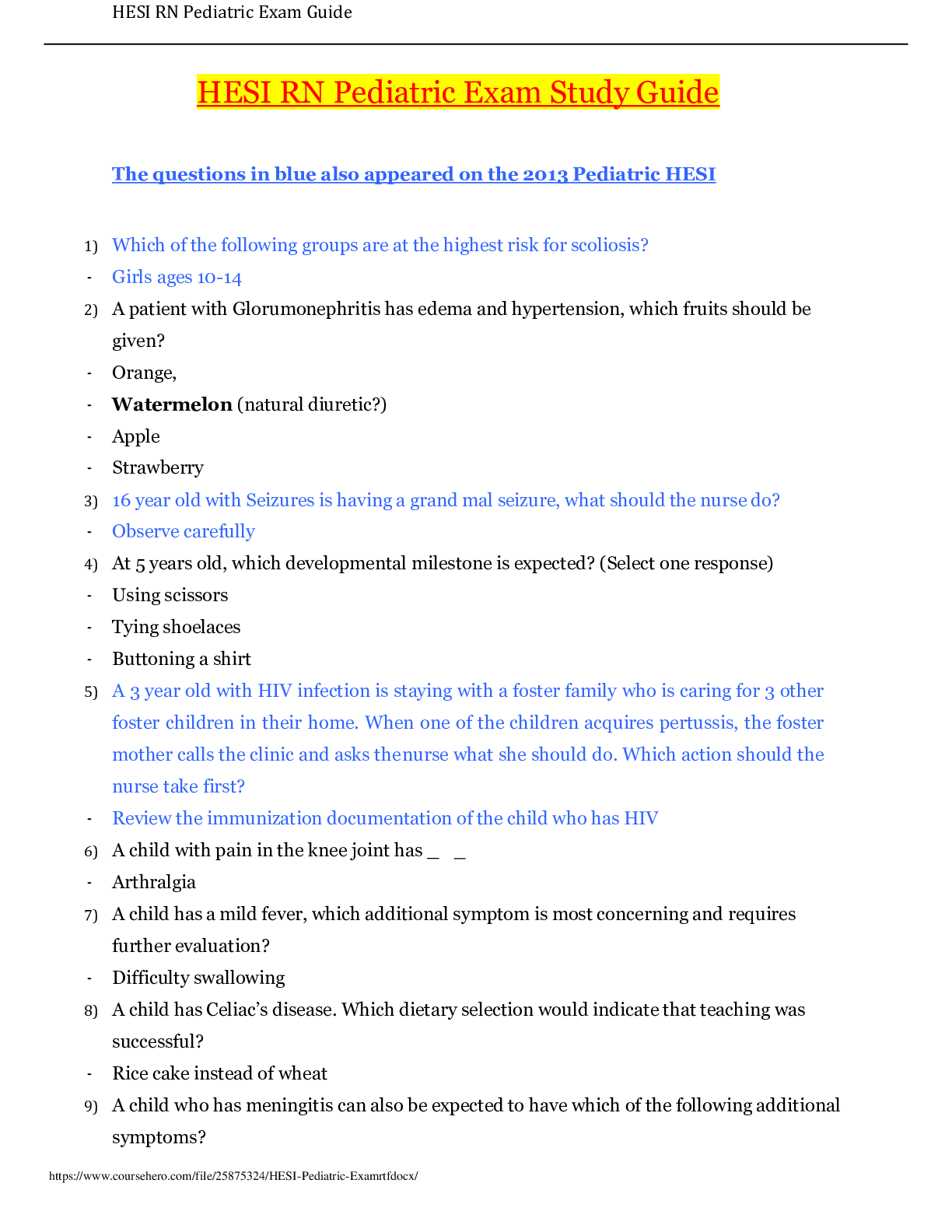
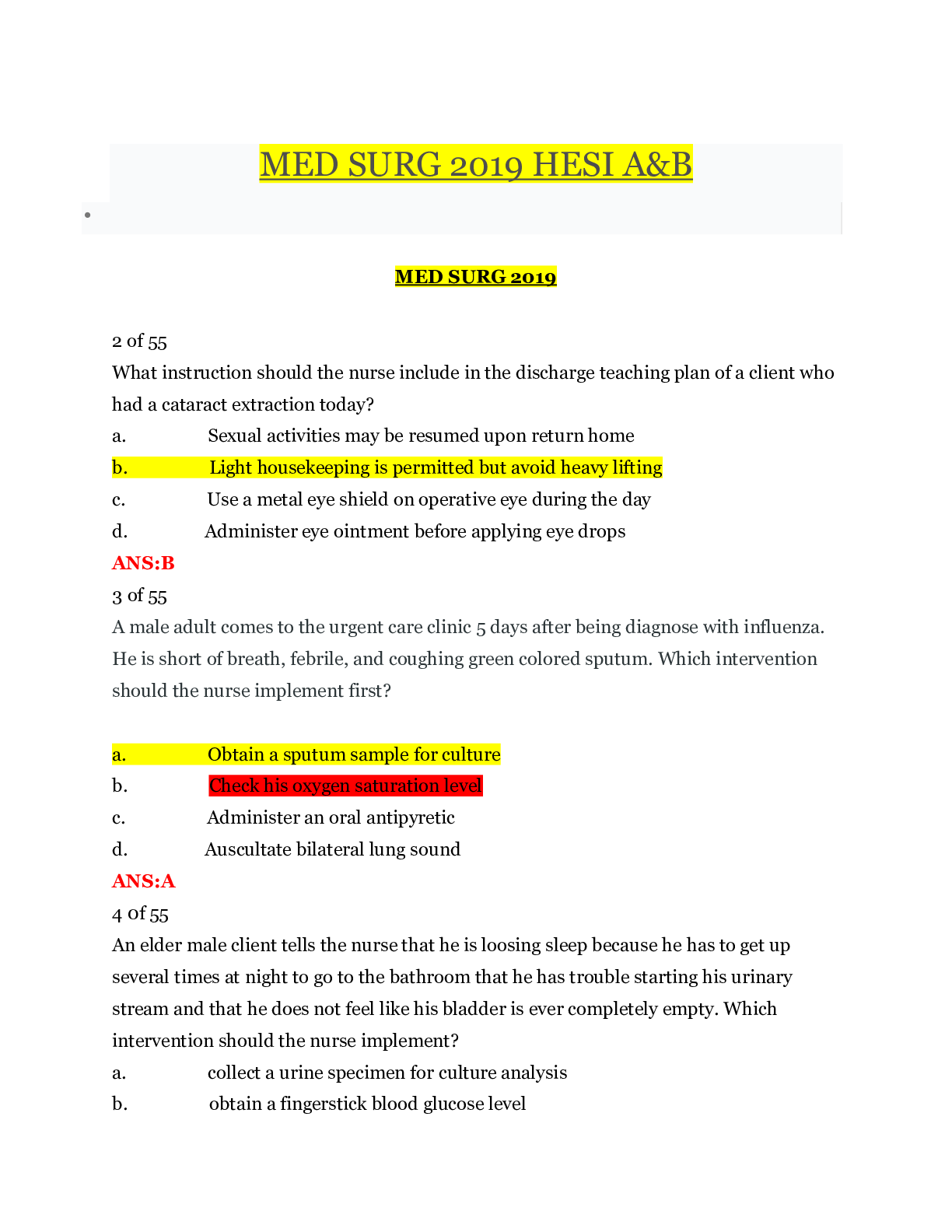
 - Over 500 Questions – Nightingale College.png)
.png)

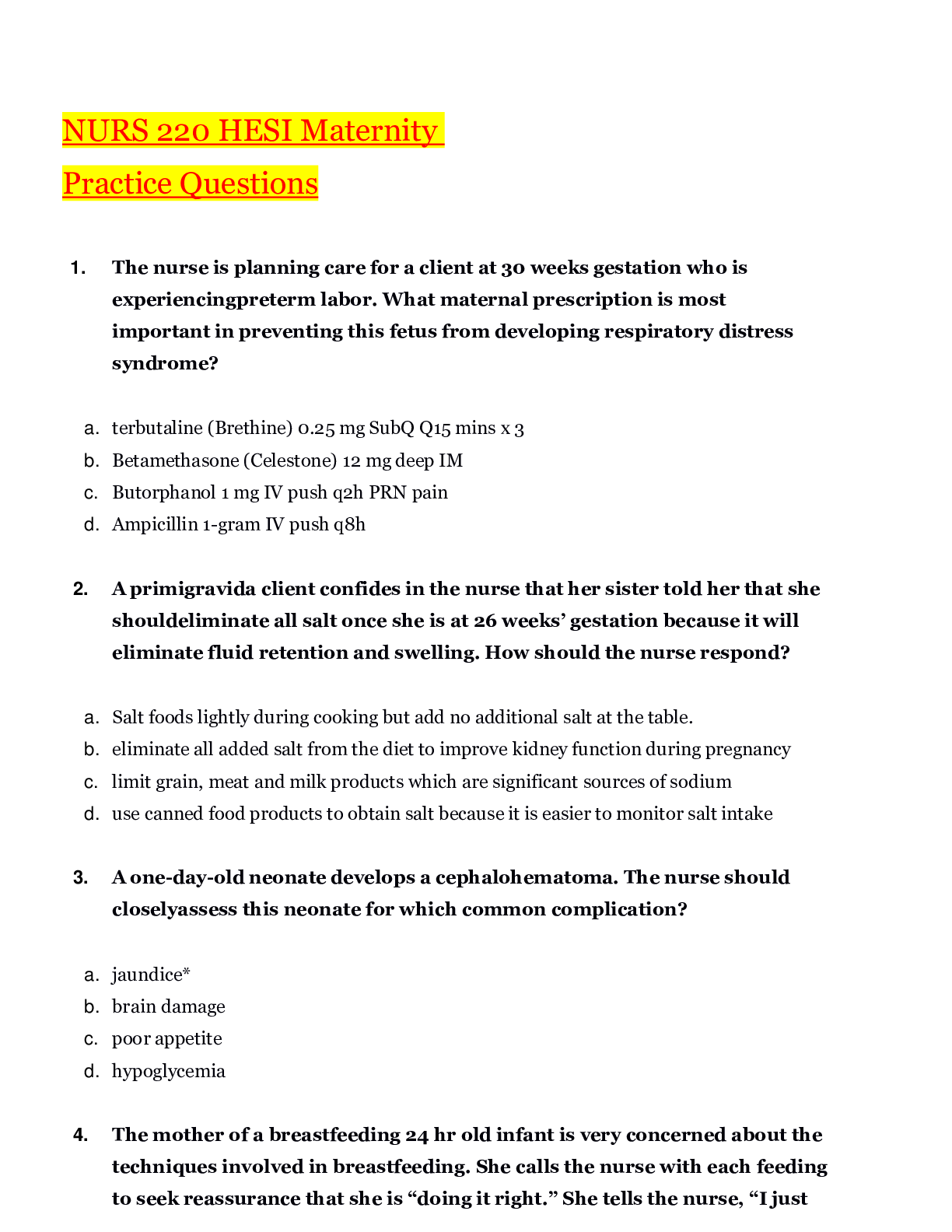
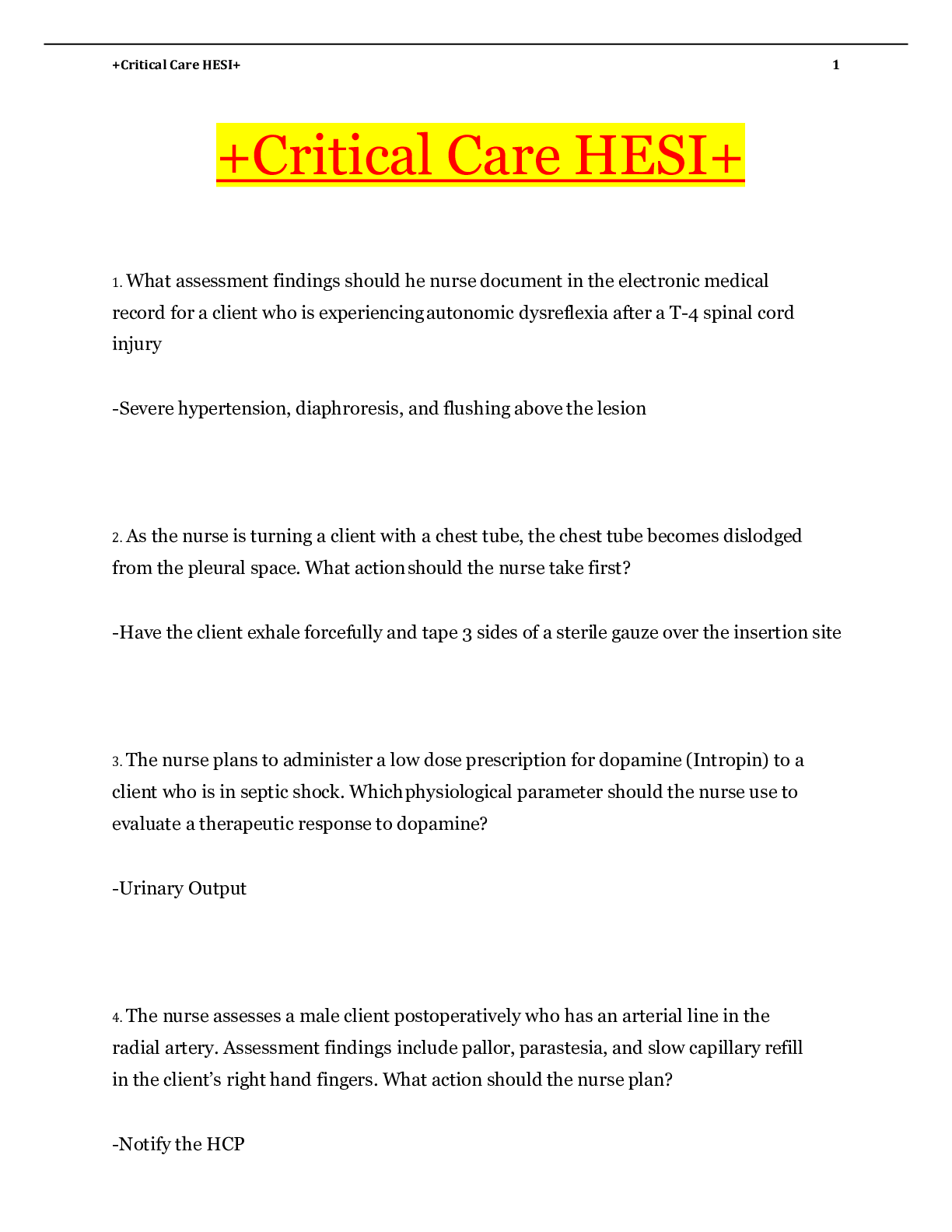
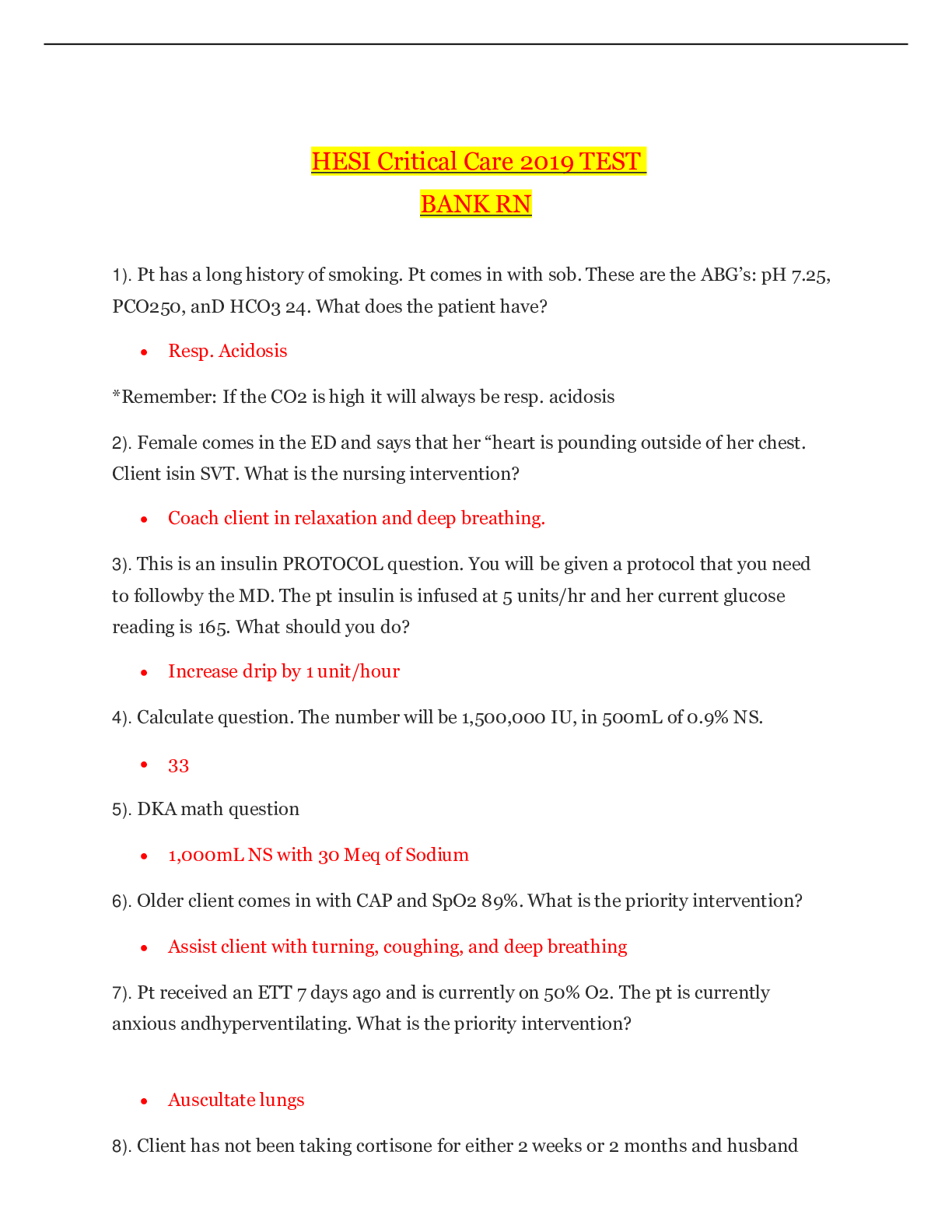
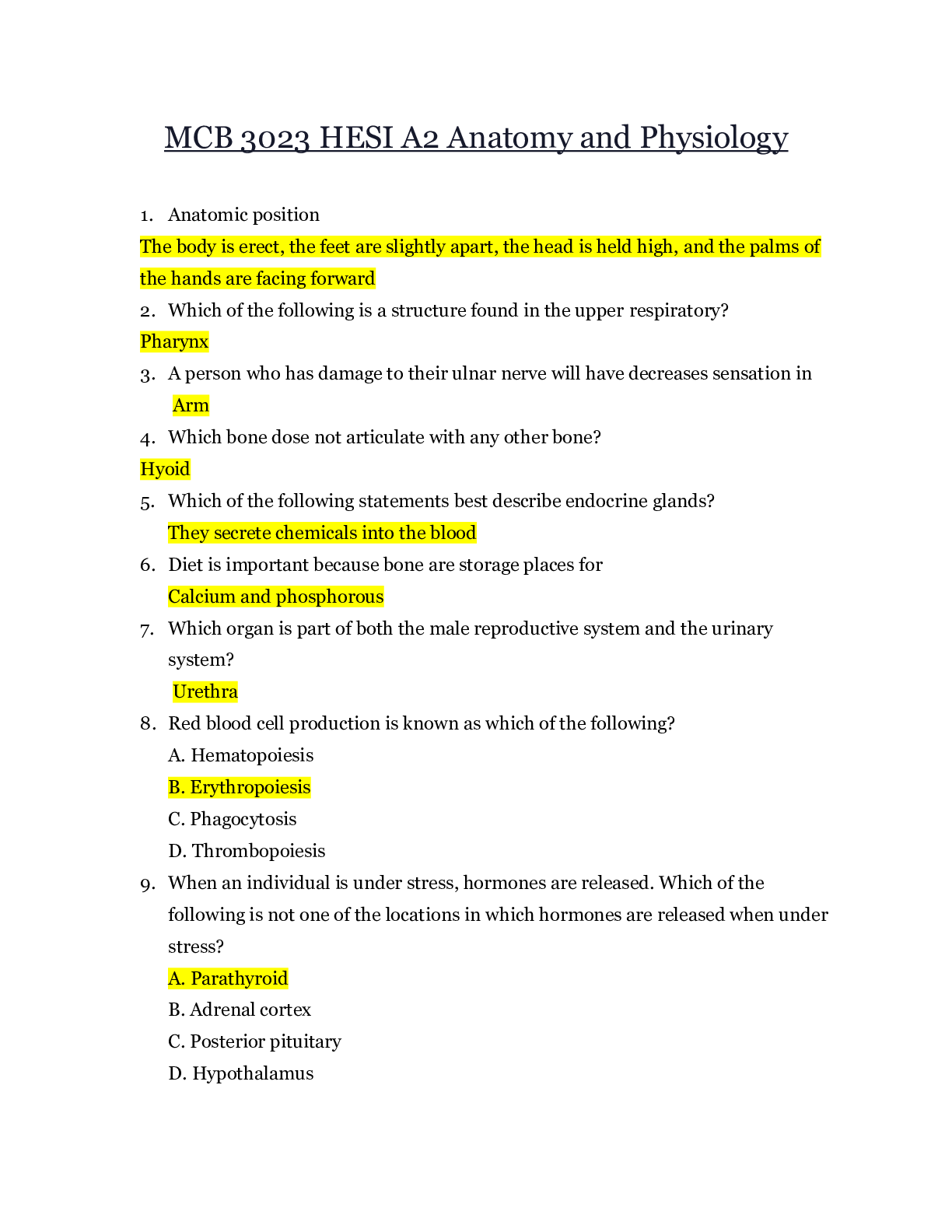



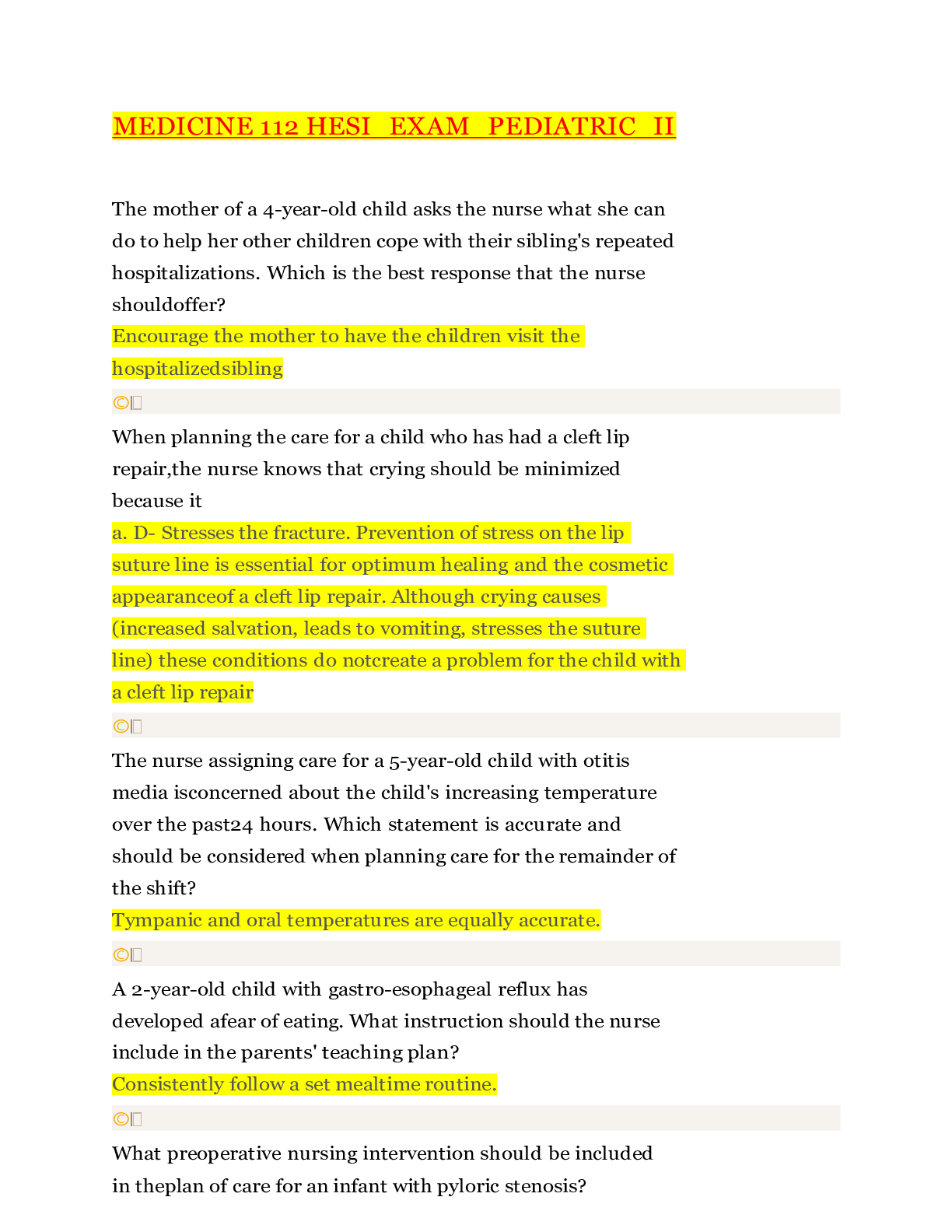

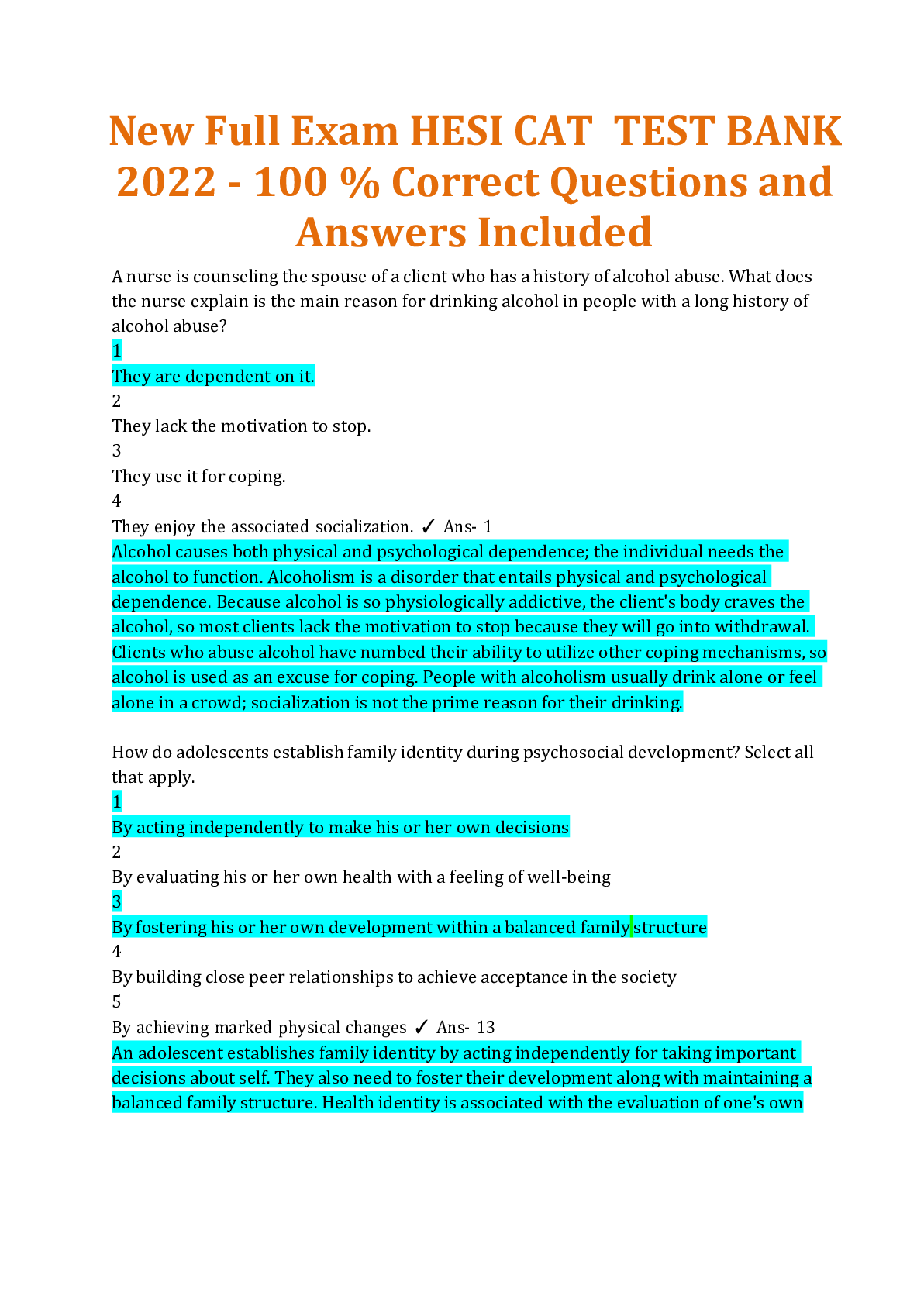
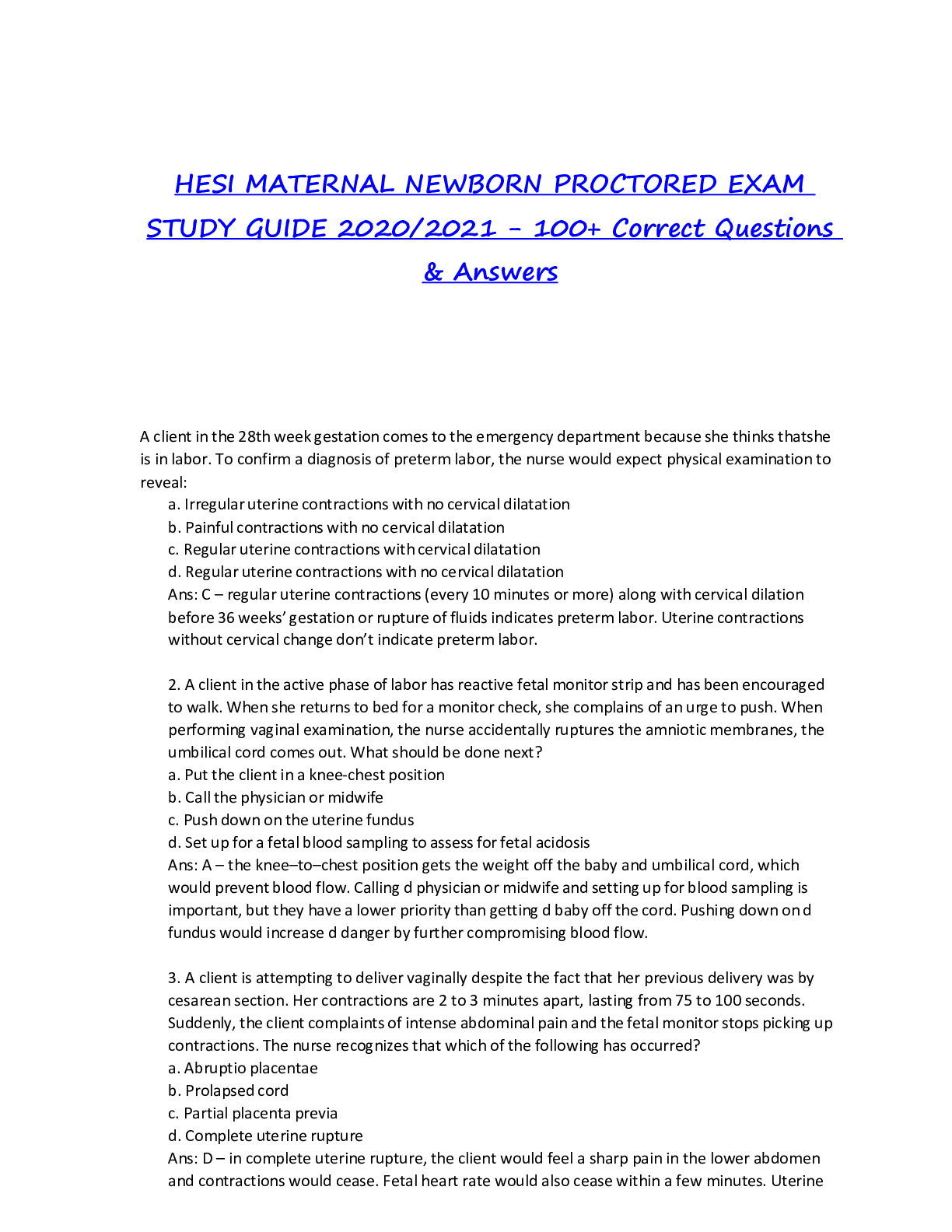

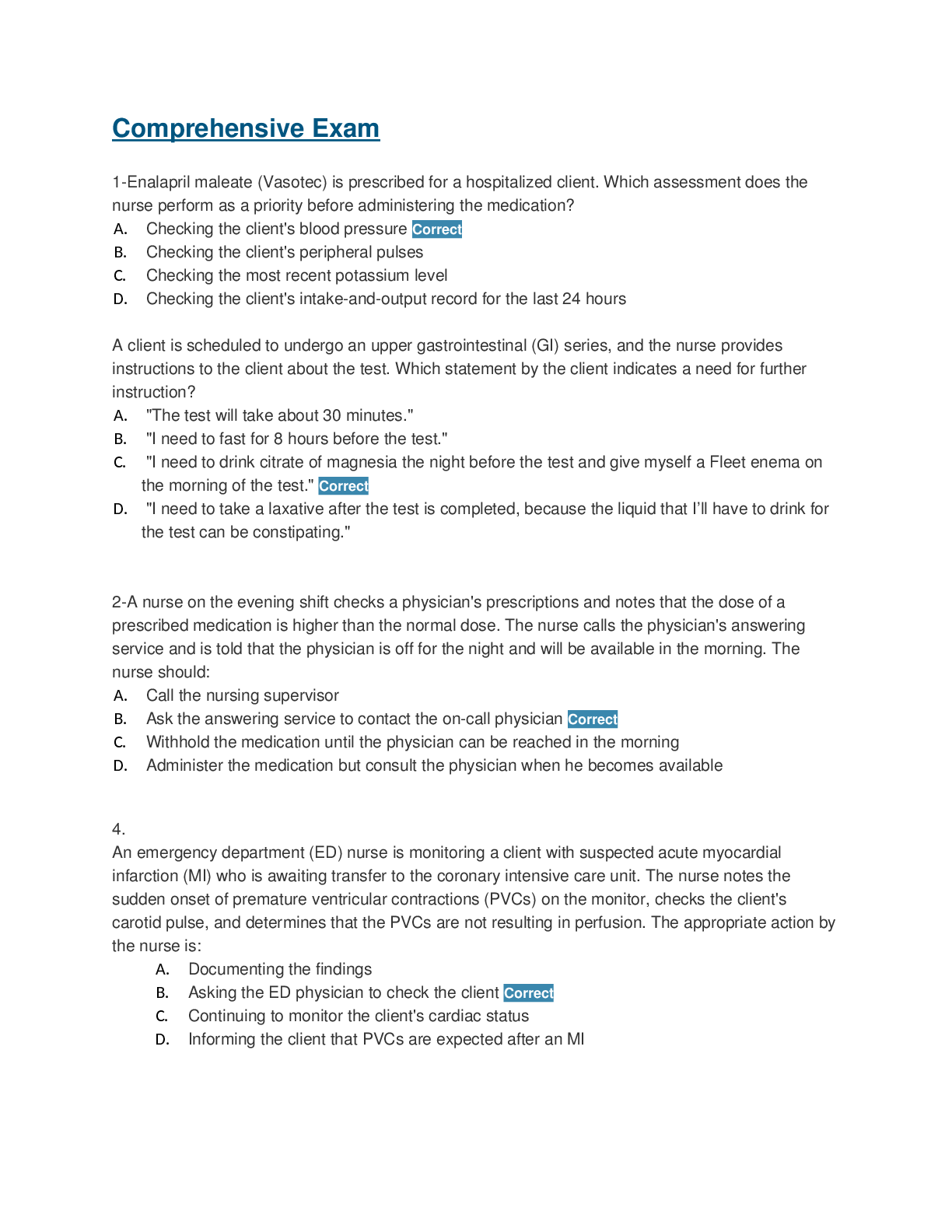

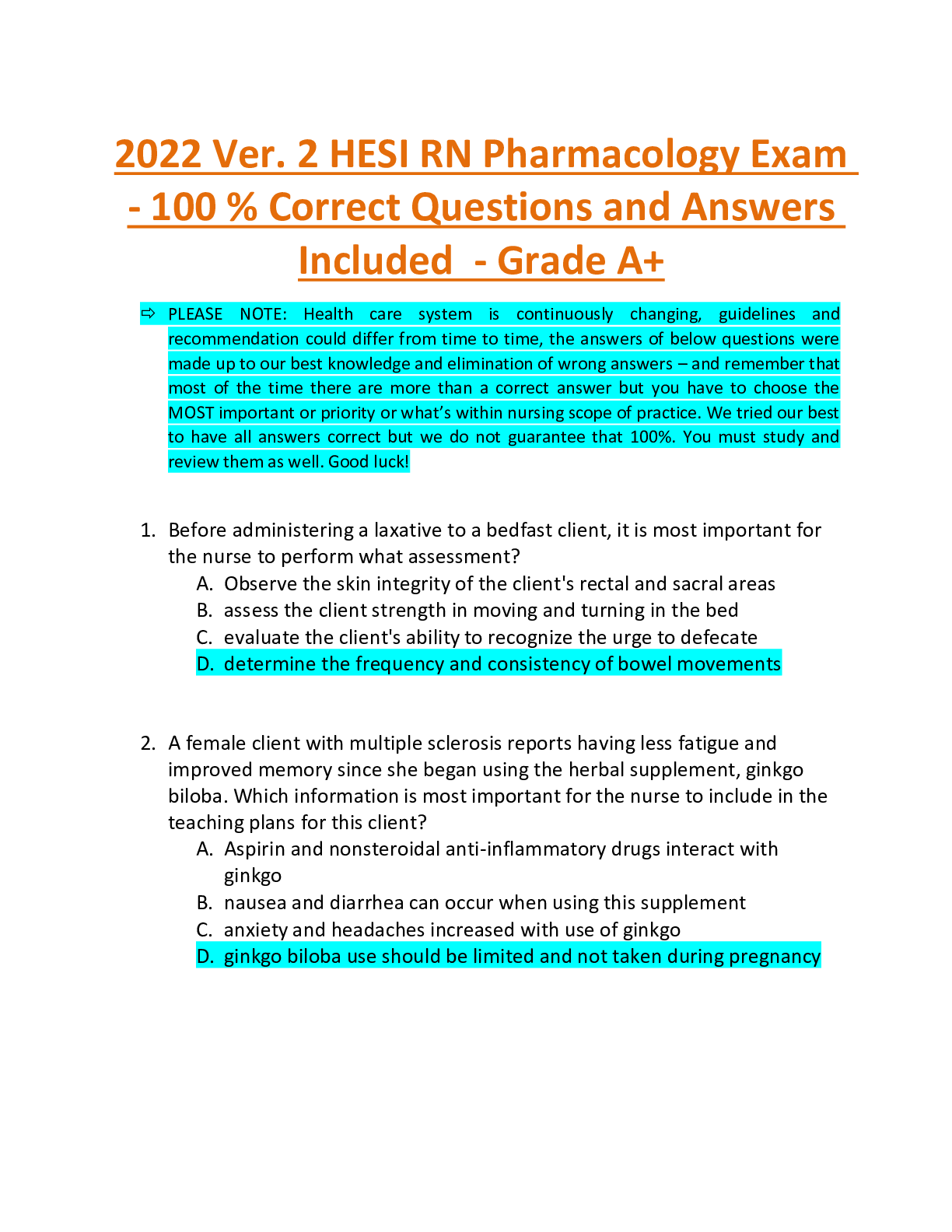
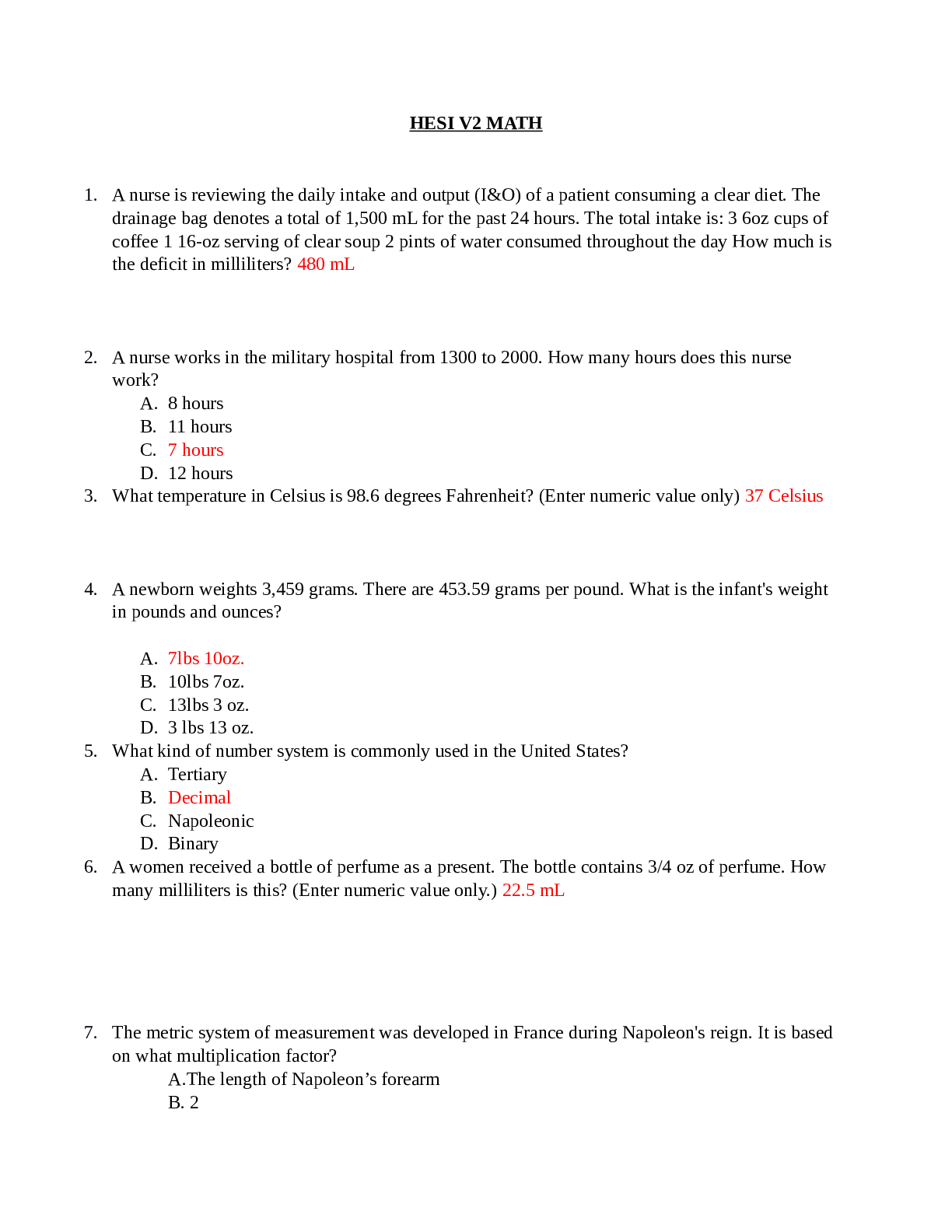
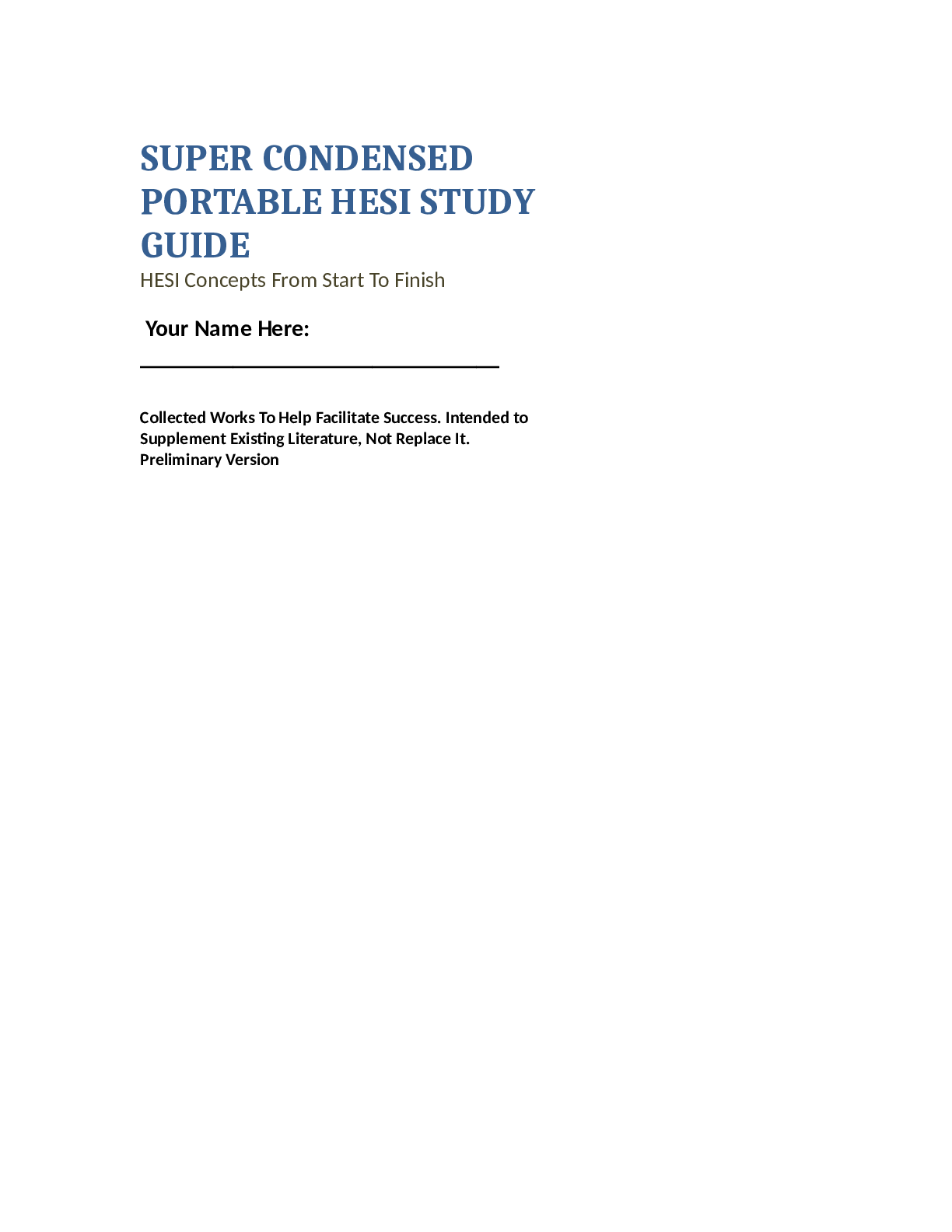




 (1).png)



